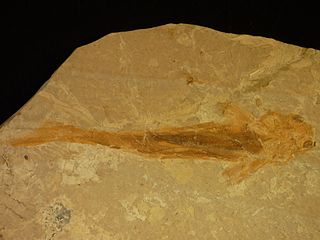Casierius is an extinct genus of marine ray-finned fish that lived during the Albian stage of the Early Cretaceous epoch. It was a relative of the modern bonefish in the extinct family Phyllodontidae, although some authorities consider it either a true albulid or a very early eel. It contains a single species, C. heckeli, known from the Glen Rose Formation near Hood County, Texas.
Enischorhynchus is an extinct genus of prehistoric bony fish that lived during the Turonian of southern Texas.
Bobbichthys is an extinct genus of marine ray-finned fish that lived in what is now Chile during the Oxfordian stage of the Late Jurassic epoch. It was a member of the Varasichthyidae, a family of potentially crossognathiform fish.
Chongichthys is an extinct genus of marine ray-finned fish that lived during the Oxfordian stage of the Late Jurassic epoch. It contains one species, C. dentatus from the Quebrada El Profeta of Chile. It is named after Chilean geologist Guillermo Chong.
Oligopleurus is an extinct genus of prehistoric bony fish that lived during the Kimmeridgian stage of the Late Jurassic epoch.
Aphnelepis is an extinct genus of prehistoric freshwater ray-finned fish that lived during the Late Jurassic epoch. It contains a single species, A. australis, from the Talbragar River beds of New South Wales, Australia.
Stichopterus is an extinct genus of chondrostean ray-finned fish that lived during the Early Cretaceous epoch in Asia. It has been found in Russia and Mongolia.
Eosaurichthys is an extinct genus of saurichthyid ray-finned fish that lived during the late Permian epoch in what is now China.
Cosmoptychius is an extinct genus of freshwater and estuarine ray-finned fish that lived during the Mississippian epoch. It contains a single species, C. striatus from the Visean of Scotland. It has a wide stratigraphic range in the Wardie Shale, with many specimens known.

Strongylosteus is an extinct genus of prehistoric ray-finned fish that lived during the early Toarcian age of the Early Jurassic epoch. Its type species is Strongylosteus hindenburgi (monotypy). It is related to modern sturgeon and paddlefish (Acipenseroidei), but with a different kind of mouth than common species, made for hunting prey in open waters, with a strong lower jaw, similar to modern beluga sturgeon.
Daitingichthys is an extinct genus of prehistoric marine ray-finned fish that lived during the Late Jurassic period. It contains a single species, D. tischlingeri from the early Tithonian-aged Mörnsheim Formation of the Solnhofen Limestone, Germany. It is thought to be a stem-elopiform, related to modern ladyfish and tarpons.
Gigantopterus is an extinct genus of prehistoric bony fish that lived during the Carnian stage of the Late Triassic epoch.
Pholidophoretes is an extinct genus of prehistoric ray-finned fish that lived during the Carnian stage of the Late Triassic epoch.
Elpistoichthys is an extinct genus of prehistoric bony fish that lived during the Carnian stage of the Late Triassic epoch.

Aetheretmon is an extinct genus of prehistoric freshwater and estuarine ray-finned fish that lived during the early Mississippian (Dinantian) age in what is now Europe, including Scotland, Belarus, and Russia. It contains only the species A. valentiacum. This genus has the oldest known actinopterygian growth series, indicating that juvenile Aetheretmon had tails similar to those of modern teleosts, but unlike teleosts, their upper tails continued to grow throughout their lives instead of truncating early. Initially classified as a "palaeoniscid", later studies have recovered it as a stem-neopterygian, or more recently a stem-actinopteran.
Ascalabos is an extinct genus of marine ray-finned fish known from the Late Jurassic Solnhofen Limestone of Germany. It contains one species, A. voithii. Some authorities synonymize it with Leptolepis.

Saurorhynchus is an extinct genus of carnivorous bony fish that lived during the Early and Middle Jurassic epochs. Fossils have been found in Europe and North America (Canada). It is commonly found in pelagic and lagoonal deposits, but mostly marine. Largest specimens can grow up to 1.9 metres (6.2 ft).

Peipiaosteus is an extinct genus of prehistoric chondrostean ray-finned fish. Its fossils are found in the Early Cretaceous Jiufotang Formation, Pani Lake, Liaoning Province, China.

Cavenderichthys is an extinct genus of prehistoric freshwater ray-finned fish from the Late Jurassic. It contains a single species, C. talbragarensis from the Talbragar Fish beds of New South Wales, Australia.

Piranhamesodon pinnatomus is a pycnodontiform fish from the Late Jurassic. It was described from the Plattenkalk deposits of the Solnhofen Formation, in Bavaria, Germany. It is notable for having sharp, serrated teeth highly reminiscent of a piranha, a highly unusual trait as most other species in the order Pycnodontiformes were shellfish eaters with flat, crushing teeth. It is also the oldest known bony fish with this trait. This unusual combination is reflected in its genus name, which is a combination of piranha and the frequent pycnodontiform genus suffix Mesodon. Fossils of other fish found in the same area have torn fins possibly attributable to this species.





